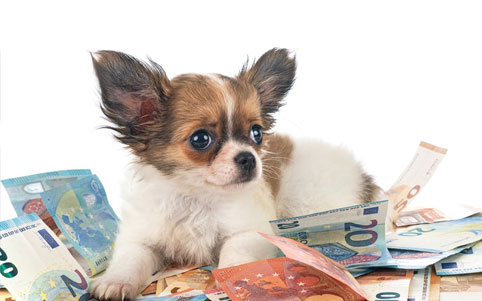For dog lovers, a puppy is the best thing in the world. For dog lovers with a talent for running a small business, starting a dog breeding business combines their passions and can be deeply satisfying on top of the financial benefits.
Like any other business though, if you’re going to start a dog breeding business you need to get a few things in order before you get started.
1. Write a business plan
Your first step after deciding on a dog breeding business should be to write a business plan. If you need financing, you’ll need to show this to most banks. If you’re fully self-financed, a business plan will lay out your goals and requirements, and lay the groundwork for a successful business.
You can find free business plan templates online, from simple templates to more complex ones.
Top business plan tip: Most local government sites will have a free template up to help new business owners and a help section to talk you through the different parts of the plan.
2. Insurance is king
Insurance is a must for any business. When starting your dog breeding business, you have to find insurance that takes your animals into account.
Any business will need insurance that covers standard concerns like fire, flood, theft and equipment.
As a dog breeder, you need insurance that covers your premises, your animals, and yourself. Public liability insurance is vital; you will be dealing with the general public on a regular basis and accidents can happen very fast.
Insurance is one of the key areas where you should never skimp. Get a full package to cover all eventualities, and give yourself peace of mind so that you can concentrate on building your business and providing the best start in life for your puppies.
Top insurance tip: Make sure you read all conditions and exclusions on the insurance pack you want before taking it out. Most insurance needs to be in place for a minimum time before claims are allowed, although some companies have coverage that starts immediately.
3. Choose a breed of dog to specialize in
You have the whole range of doggydom to choose from here. If you already have a dog breed you know and love, this choice will be easier, but if you’re starting from scratch you’ll want to do your research carefully. For first time breeders, you’ll be better off choosing a single breed to start with and investing in the best bitch you can find.
Are you breeding for family pets, show dogs, or working dogs? Will your local market support the breed you chose? It’s an unpleasant fact that dog breeds go in and out of fashion, and some breeds suffer from discriminatory legislation. If you’re breeding specifically for family pets, you need to ensure that you have a market for your dogs, and that you are in code with your local by-laws.
Different breeds can have very different temperaments and requirements, and every dog breed has potential health and behaviour issues you need to be aware of before starting your programme.
Large breeds need a lot more space and exercise, so keep in mind the size of the dog and your available property before you pick your pup.

4. Avoid trend breeding
If you’re breeding specifically to meet a trend, what are your plans for when that trend ends?
101 Dalmatians resulted in an explosive demand for dalmatian puppies, only for a huge number of those dogs to end up in shelters when the owners realised they could not cope with the breed. Game of Thrones did the same thing to huskies.
Unscrupulous breeders took advantage of the demand and bred for speed instead of good genetics, and released animals with health and temperamental issues to new owners who had no idea of how to deal with them.
The people who bought these animals took two working dog breeds and tried to turn them into lapdogs, and the results will always be catastrophic. Until humans stop being influenced by media, trend breeds will remain a thing, but it’s unfair to the dogs.
Breeding to trend raises serious ethical issues, and can lead the buyer off of a financial cliff. If you want a long term business here, it’s a practice best avoided.
5. Write a detailed budget
Expenses for any business add up in a hurry, and dog breeding is no exception.
When you’re starting up, you’re going to want to price everything you’ll need in advance, plus have a surplus for unexpected expenses – and with animals, there are always unexpected expenses.
You need to budget for food, equipment, vet fees and potential emergencies, stud fees, travel and marketing as a starting point. If you intend on running your dog breeding business as your main income earner, you’ll need to include rent or mortgage and utilities as an extra expense. A genealogy programme is a nice to have – you can go old school with pen and paper, but checking lines manually can take hours of work. If you can afford it, add it to your budget.
Once the pups arrive, you’ll have your puppy packs and promotional materials to add, plus registration fees and vaccinations.
Top budget tip: Work out what you think it will cost, and add at least 40%. There are always unexpected expenses.
6. Get the right equipment
Everything from crates to dog bowls to the collars and leads are dependent on two things: the size of the dog breed and your budget.
This includes the property you are using; there is a massive difference between the size requirements for say, a chihuahua versus a great dane.
Equipment can range from home-made, to pre-made budget items, to top-of-the-line luxury. Choose what’s right for your dogs and your finances, and budget wisely.
Top equipment tip: Start with budget-appropriate affordable items, and reinvest some profit into upgrading equipment.
7. Keep it legal
Different countries and local areas have licensing requirements for breeders, and you need to check to make sure you’re compliant.
Check with your local council and make sure you meet all of the licence requirements – any buyer is going to want to see your licence before shelling out for a puppy, and display your licence prominently to greet your customers when they visit your property.
Top licence tip: Being a licenced seller gives your business credibility and peace of mind to your buyers. Make sure you note it on your website.
8. Market yourself on social media and get your website up and running
Social media is the making or breaking of a small business in todays world. A dog breeding business is perfect for picture rich sites like Instagram and TikTok, and will drive customers to your website.
Make sure you update your social media on a regular basis, because your followers will drop away otherwise. You want a reputation for reliability, and that starts with your marketing.
Keep your website up-to-date with a weekly or monthly blog, including count-down posts to puppy day. Make sure to interact with fans who reach out to you and keep things light-hearted and pleasant.
A business is completely reliant on their customer base and public image, and poor reviews can sink you faster than you think. What you post on the internet is permanent.
Keep your business and personal feeds strictly separate, and be careful about what you post if it’s not related to your business.
Top social media tip: Once the puppies are on their way, setting up a live feed in the birthing crate can really get your audience invested in your dogs.

9. Open a separate bank account
A separate bank account makes it easier to track your income and expenses for your business. It’s a lot harder to budget if your business finances keep getting mixed up with your weekly shopping.
Most banks will have a small business account option, including lower fees up to a certain income level.
Using a business account to pay any salaries, website costs and other expenses makes it a lot easier to deal with tax season; keeping your records up to date in an easily accessible trail means never getting confused over whether you’re operating in the green or not.
Top banking tip: There are now multiple online banks that offer business accounts for small and new businesses. They often have lower fees than the standard banks, and many will look at all credit levels.

10. Save up for a rainy day
Save a percentage of your earnings and put it aside for emergencies every month.
This needs to cover anything from broken equipment to emergency vet visits, so it’s a vital step for your dog breeding business.
While the right insurance will cover you for most issues that come up, emergencies almost always need a cash outlay at the time. Putting money aside on a monthly basis means you don’t have a sudden unexpected expense taking a massive chunk out of your hard-earned cash flow.
Top savings tip: Aim for 20%, but realistically 15% of your income should be tucked away. Try and put this money into the highest interest earner you can find, while still being able to access it immediately.
11. Find a vet you trust
For any animal owner, a vet you can trust is important. As a dog breeder, a vet you connect with is a vital investment in your business.
Not all vets are created equal. Some are better with large animals, some with small. Even the best dog-orientated vet is going to have breeds they are just better at handling. It’s important you find someone has a rapport with both you and your dogs. You and your dogs will be happier and more confident during visits.
For a good vet, word-of-mouth is the way to go. Online reviews can be useful as guidelines, but speaking to people who take their loved pets to a vet and either rant or rave about them is the best way to narrow the field down, followed by a visit to the surgery.
You want a surgery that is clean, friendly, and ensure people keep visiting animals under control at all times. A surgery that is dirty, chaotic, with surly, unhappy front-of-house staff is unlikely to give you the best treatment for your animals.
Your vet is going to be one of your best friends especially during puppy season. You’ll be visiting for vaccinations, help during pup delivery, and check-ups as well as any accidental mishaps. Some vets are happy to assist during the breeding process as well; this will depend on the vet, the practice policy, and your relationship with them.
You’ll likely end up on first name terms with most of the staff.
Top vet tip: A good vet will happily give you advice and guidance on how to keep your animals healthy and happy – vets love animals, and their priority is always going to be your dogs. If you find a new bit of kit or fancy food that you’re unsure of, checking with the vet is a great idea.
Once you’ve ticked off this list, you’re ready to start the best job ever. Dog breeding is hard work, but one of the most rewarding and fulfilling jobs you could ever do.
You get to work with some of the best animals on the planet, with unconditional love from your furry employees – there aren’t many bosses who can say that!
Need more? We’ve got a great dog breeders insurance package, tailor-made for your peace of mind and business needs.